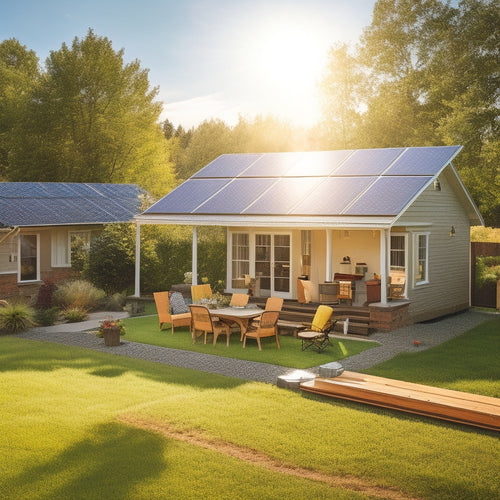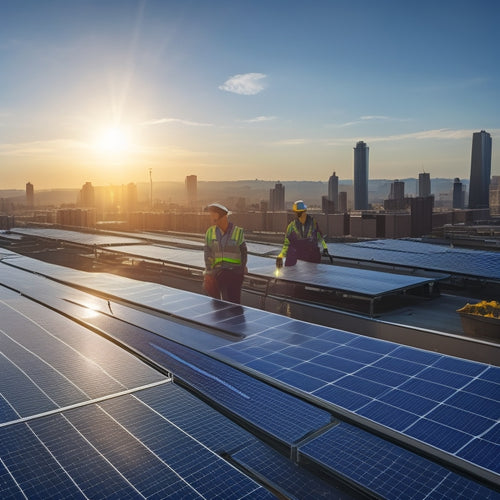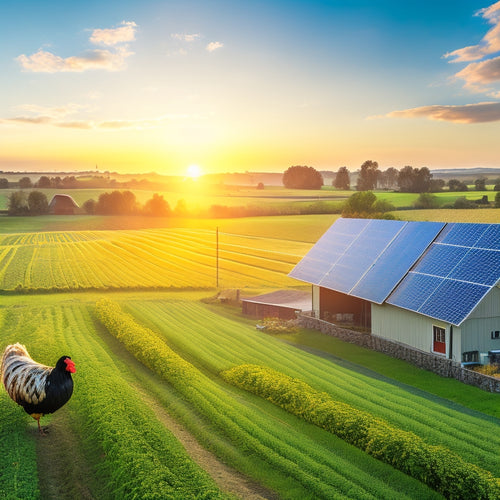
What to Expect From Home Solar Panel Installation Costs
Share
When considering home solar panel installation, you can expect to pay between $15,000 and $40,000 or more, depending on various factors such as system size, panel type, and installation company. The cost breakdown reveals that 90% of the installation cost goes towards solar panels, with higher-quality equipment warranting better performance and longer lifespan. System size, efficiency, and roof complexity also impact costs. Additionally, local incentives, financing options, and maintenance requirements can affect the overall expense. As you investigate the specifics of solar panel installation costs, you'll realize how these variables intersect to shape your unique investment.
Key Takeaways
- The majority of installation cost (around 90%) is attributed to the solar panels themselves, with panel type affecting price.
- System size significantly impacts upfront costs, with larger systems generating more energy but costing more.
- High-quality equipment and warranty coverage are crucial for minimizing maintenance costs and ensuring long-term performance.
- Choosing a reputable installation company with experienced contractors is vital for ensuring a successful project and optimal system performance.
- Local incentives, such as tax credits and rebates, can significantly reduce the overall cost of solar installation.
Understanding Solar Panel Prices
About 90% of the overall cost of a home solar panel installation comes from the solar panels themselves, making understanding solar panel prices an essential step in determining the viability of a solar energy system for your home.
You'll want to evaluate the type of solar panels you need, as prices vary depending on the quality, efficiency, and brand. Monocrystalline silicon panels, for instance, are more expensive than polycrystalline silicon panels, but they offer higher energy conversion rates.
When evaluating solar panel prices, you should also examine financing options. While purchasing solar panels outright may be cost-prohibitive for many homeowners, financing options like loans or power purchase agreements (PPAs) can make solar energy more accessible.
With a loan, you'll pay for the system upfront, but you'll own it and benefit from the savings on your electricity bill. A PPA, on the other hand, allows you to pay a fixed rate for the electricity generated by the system, with the financing company owning the system.
Understanding these financing options will help you make an informed decision about investing in a solar energy system for your home.
System Size and Cost Factors
Efficiency meets economy when it comes to determining the ideal system size for your home solar panel installation. You want to guarantee you're generating enough power to meet your energy needs, but not so much that you're wasting money on excess capacity.
The system size you need depends on several factors, including your energy usage, roof size, and local building codes. Generally, a larger system will generate more energy, but it will also cost more upfront.
Here's a breakdown of how system size affects cost and energy savings:
| System Size (kW) | Cost Range | Energy Savings (kWh/month) |
|---|---|---|
| 3-4 kW | $15,000-$20,000 | 300-400 |
| 5-6 kW | $25,000-$30,000 | 500-600 |
| 7-8 kW | $35,000-$40,000 | 700-800 |
| 9-10 kW | $45,000-$50,000 | 900-1,000 |
| 11-12 kW | $55,000-$60,000 | 1,100-1,200 |
Keep in mind that panel efficiency also plays a role in determining the system size you need. More efficient panels require less surface area to generate the same amount of energy, which can reduce your overall costs.
Equipment Quality and Warranty
When you're investing in a home solar panel installation, nearly every component comes into play, but few are as critical as the equipment itself. The quality of your solar panels, inverters, and mounting systems can greatly impact your system's performance, efficiency, and lifespan.
High-quality installation materials are vital to guarantee peak energy production and minimize maintenance costs.
You should also consider the warranty coverage offered by the manufacturer. An all-encompassing warranty can provide peace of mind and protect your investment. Look for a warranty that covers the system's performance, parts, and labor for at least 25 years. Some manufacturers even offer extended warranty options or performance guarantees.
When evaluating equipment quality and warranty, research the manufacturer's reputation, read reviews, and ask about their testing and certification processes.
A reputable manufacturer will stand behind their products and provide reliable warranty coverage. By choosing high-quality equipment with extensive warranty coverage, you can guarantee your solar panel installation meets your energy needs and provides a strong return on investment.
Installation Company and Labor Costs
Two vital factors in determining the overall cost of your home solar panel installation are the installation company and labor costs.
You'll want to research and select a reputable installation company with a proven track record of successfully completing projects similar to yours. A qualified contractor will have the necessary knowledge, certifications, and licenses to guarantee your installation meets local building codes and industry standards.
Their experience will also impact the installation processes, as they'll be able to efficiently manage the project timeline, minimizing delays and reducing labor costs.
Contractor qualifications, such as NABCEP certification, are essential in assuring a high-quality installation. A certified contractor will have the knowledge and skills to design and install a system that meets your energy needs and optimizes energy production.
When evaluating installation companies, be sure to ask about their contractor qualifications, installation processes, and warranties offered. This will help you make an informed decision and guarantee you're getting the best value for your investment.
Roof Size and Complexity Matters
Evaluating your roof's size and complexity is an essential step in determining the cost of your home solar panel installation. A larger roof requires more solar panels, increasing the overall cost. Additionally, a complex roof with multiple angles, skylights, or vents may require specialized installation equipment and techniques, adding to the expense.
When analyzing your roof's complexity, consider the following factors:
-
Roof orientation: The direction your roof faces affects the amount of sunlight it receives, which impacts the number of solar panels needed. South-facing roofs receive the most sunlight, while north-facing roofs receive the least.
-
Shading analysis: Trees, buildings, or other obstructions can cast shadows on your roof, reducing the amount of sunlight available for your solar panels. A shading analysis helps determine the best placement for your panels to maximize energy production.
-
Roof layout and obstacles: Skylights, vents, and other roof features can make installation more challenging and increase costs. A thorough evaluation of your roof's layout helps your installer determine the most efficient and cost-effective installation strategy.
Local Incentives and Rebates Available
You'll be happy to know that there are several incentives and rebates available to help offset the cost of installing solar panels on your home.
At the federal level, you can claim a tax credit of up to 26% of your total installation cost.
Additionally, many states and local governments offer their own incentives, such as rebates, tax credits, or property tax exemptions, which can further reduce your out-of-pocket expenses.
Federal Tax Credits
Fortunately, homeowners who invest in solar panel installation can often offset a considerable portion of their upfront costs through federal tax credits.
These credits can greatly enhance your investment returns, making solar energy a more affordable and attractive option.
You can claim a tax credit of 26% of the total cost of your solar panel system, including equipment and installation.
Here's how it works:
-
Claim the credit: You'll need to file IRS Form 5695 with your tax return to claim the credit. Be sure to keep detailed records of your solar panel installation, including receipts and invoices.
-
Apply the credit: The tax credit will reduce your federal income tax liability, dollar for dollar. If the credit exceeds your tax liability, you can carry the excess credit forward to future tax years.
-
Combine with financing options: You can also combine the federal tax credit with other financing options, such as state and local incentives, to further reduce the upfront cost of your solar panel installation.
State and Local Offers
In addition to the federal tax credit, many state and local governments offer their own incentives to encourage homeowners to switch to solar energy. These state and local offers can greatly reduce the upfront cost of installing solar panels on your home. You may be eligible for rebates, grants, or property tax exemptions, depending on where you live.
You'll need to research the specific state regulations and incentives in your area. Some states offer financing options, such as low-interest loans or property-assessed clean energy (PACE) programs, which can help you cover the initial cost of installation.
Others provide rebates or credits that can be used to offset the cost of your solar panel system. It's essential to understand the local incentives available to you, as they can vary widely.
For example, some states offer a rebate of $2.50 per watt, while others provide a tax credit of up to 25% of the total system cost. By taking advantage of these state and local offers, you can greatly reduce the cost of going solar and start generating clean energy for your home.
Ongoing Maintenance and Repair Costs
Solar panel systems require periodic maintenance to guarantee peak performance and extend their lifespan.
You'll need to budget for ongoing maintenance and repair costs to keep your system running efficiently.
To promote solar panel longevity, you'll need to perform routine maintenance tasks:
- Clean the panels: Dust and debris can reduce energy output, so cleaning the panels every 6-12 months is essential.
- Inspect the system: Regular inspections can identify potential issues before they become major problems. Check for loose connections, damaged components, and signs of wear and tear.
- Monitor performance: Keep an eye on your system's performance to detect any drops in energy output, which could indicate a problem.
The maintenance frequency will depend on your system's size, location, and usage.
On average, you can expect to pay around $100-$300 per year for maintenance and repairs.
While these costs may seem insignificant compared to the overall installation cost, they're vital for maximizing your investment and safeguarding a long-lasting system.
Frequently Asked Questions
Can I Install Solar Panels on a Metal or Tile Roof?
You can install solar panels on a metal or tile roof, but you'll need to contemplate metal roof's structural integrity and potential rust, while ensuring tile roofs are compatible with solar panel brackets and won't compromise waterproofing.
Do Solar Panels Increase My Property Value?
You'll be pleased to know that solar panels increase your property value, as they're viewed as a desirable feature during a property appraisal, offering long-term solar panel benefits that enhance your home's appeal to potential buyers.
Can I Sell Excess Energy Back to the Grid?
You can sell excess energy back to the grid through net metering benefits, which allow you to offset your energy consumption and potentially earn credits; many utilities also offer energy buyback programs, giving you financial incentives for excess energy production.
Will Solar Panels Void My Roof Warranty?
You'll be surprised to know that 70% of homeowners consider solar panels a top priority! Now, about your concern: solar panels typically won't void your roof warranty, but it's essential to review the warranty terms, as installation impact can affect roof warranty implications.
Are There Any Solar Panel Financing Options Available?
You'll find various financing options for solar panels, including solar loans with attractive interest rates, leasing options that reduce upfront costs, and incentives like tax credits, energy savings, installation incentives, and government rebates to offset the initial investment.
Conclusion
You've made it to the finish line! Now that you've got a handle on the various factors influencing home solar panel installation costs, you're ready to shine like a superstar in the renewable energy universe! Remember, a quality installation can save you a small fortune in the long run, and with the right incentives, it's more affordable than you think. So, go ahead, capture the power of the sun, and bask in the glory of saving the planet (and your wallet)!
Related Posts
-

Steps to Prepare for Solar Installation
To prepare for solar installation, start by evaluating your current energy consumption and future needs to determine ...
-

Solar Installation Guide for Commercial Properties
Implementing solar energy solutions in your commercial property can lead to significant long-term savings and sustain...
-

Solar Power Advantages for Rural Communities
Solar power presents numerous advantages for rural communities. You can greatly reduce energy costs, potentially by u...


